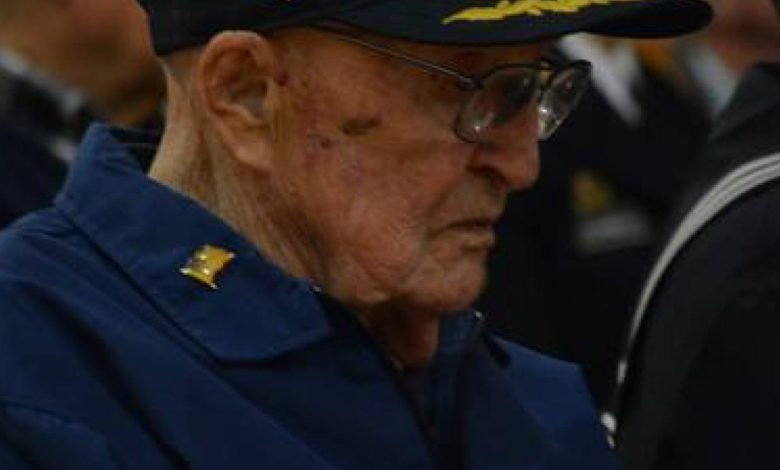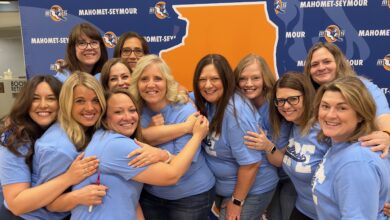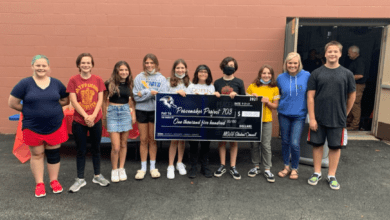94-year old survivor of USS Indianapolis recounts experience

*Art Leenerman is 94-years old. This picture was taken on Nov. 5, 2018.
By FRED KRONER
fred@mahometnews.com
Some words can be used to form sentences that are both accurate and misleading at the same time.
Try this one, for example.
Arthur Leenerman and his crew mates didn’t know what they were doing when they left San Francisco on July 16, 1945 aboard the USS Indianapolis.
It sounds harsh.
They certainly knew how to operate the 610-foot long ship and how to navigate toward their destination in the South Pacific, Tinian Island.
“We’d been there and helped recapture the island,” Leenerman said.
On another level, however, they were truly clueless.
Leenerman, who later lived with his family in Spring Lake for 45 years, said the 1,157 sailors had no idea what they were transporting.
“A truck pulled up to the harbor in San Francisco (with the cargo),” Leenerman said. “They wouldn’t tell the captain what it was.
“Someone told him we had to take it. We left right away.”
The crew deduced it was something of significance.
“We usually carried two planes,” Leenerman said in an interview last week. “This time, we only had one.”
The second hangar was not empty.
Their delivery was packed in wood and “reinforced,” the 94-year-old Leenerman said. “You couldn’t tell what it was.”
The 39 Marines assigned to the USS Indianapolis made sure the hangar was well-protected.
“They kept guard 24 hours a day,” Leenerman said.
Only later — ”after the war was over,” Leenerman said — did the crew learn the nature of the top-secret cargo.
On July 26, 1945, the USS Indianapolis delivered the components of the atomic bomb that would be dropped on Hiroshima.
“Some reports said we were carrying parts,” Leenerman said. “Actually, we had the whole thing.”
It was by chance that the USS Indianapolis was chosen as the hauler.
“We’d just gotten repaired after a kamikaze plane attacked us in Okinawa,” Leenerman said.
As history has documented, the transport is only one part of the story.
Four days after leaving Tinian Island en route to the Philippines, preceded by a brief stop in Guam, the USS Indianapolis was hit by two torpedoes launched by the Japanese.
“There had been a destroyer sunk out there the week before,” Leenerman said. “I don’t know why the captain sent us without an escort.
“The first torpedo took off the bow. The second hit the ammunition magazine.”
Published reports said the USS Indianapolis sunk in about 12 minutes in an area where the water is an estimated 3 1/2 miles deep.
In August, 2017, the ship was located, but will remain at its underwater location.
An estimated 300 sailors were trapped in the engine room and went down with the ship. More than 900 others — including the 21-year-old Leenerman — wound up in the shark-infested waters of the Pacific Ocean.
The attack took place shortly after midnight on Monday, July 30, 1945 — reports place the time of the attack at 12:14 a.m. — and Leenerman remembers feeling optimistic about a quick rescue.
What he and his crew mates didn’t know was that while their secretive mission was completed, Naval leaders were not immediately aware that the ship was missing.
“After two days (at sea), you almost can’t remember what is going on,”Leenerman said. “After four days, you’re completely out of it.”
It took 63 hours before the survivors were spotted by chance by Navy pilot Lt. Wilbur Gwinn.
During a flyover, he saw movement in an oil slick in the water on Thursday, Aug. 2, 1945.
By then, nearly two-thirds of the crew were deceased. It was recorded as the worst open-seas disaster in Naval history.
Leenerman was almost one of the casualties.
The first rescue plane to arrive was piloted by Adrian Marks.
Leenerman said his memory of events had to refreshed later.
“For a couple to three weeks, I didn’t remember anything that transpired,” he said.
He eventually had the opportunity to meet his rescuer, Marks.
“He said, ‘I took you out of the lifeboat last because I thought you were dead,’ “ Leenerman related. “They had me in a body bag and I guess I moved and they thought I was alive.”
Leenerman — who still drives “short distances,” he said — plans to be in Gibson City on Monday for a Veterans Day observance.
Though he has lived in Mahomet longer than any other community, Leenerman was raised in Ford County.
He was one of 18 graduates in Sibley High School’s Class of 1942.
“All the boys but a couple in my class went in the Navy,” Leenerman said.
He had a specific reason for his choice.
“I thought it would be better than trumping around in the mud and sleeping on the ground,” Leenerman said. “And I got on the Indianapolis, which was good.”
It was considered a choice assignment.
“It had anything you wanted,” he said. “A barber shop. A bake shop. Food.
“They could make ice cream and we’d trade with other ships for movies. The only basic problem was it was warm. A lot of times, I slept up above the deck, I slept in the searchlight platform.”
The rescue operation picked up 321 survivors, four of whom died within weeks.
Of the remaining 317, Leenerman was one of just 14 living in July, 2018.
“Six of us were there at the reunion,” Leenerman said.
The site for reunions is always consistent. It’s a natural selection.
“Indianapolis,” said Leenerman, who began attending survivor reunions in 1960 and has only missed one since then.
The gatherings attract more than the men who were on the USS Indianapolis in July, 1945.
Greg Leenerman — a 1971 Mahomet-Seymour graduate and Arthur’s only child — has accompanied his father in recent years.
“My (two) girls look forward to attending,” Greg Leenerman said. “They’ve taken time off from work to come.
“You see that with all of the survivors. It’s a whole little posse, kids, grandchildren, nieces and nephews. It has turned into a family event.”
The reunions, and other opportunities Greg Leenerman has had to hear his father speak, were an education for him.
“Through those, I got the history,” Greg Leenerman said. “I was in high school or college before I was aware of what went on there. Art didn’t talk about it a lot as I was growing up.
“When you pull back history, you get the perspective of how big it was. Without the atomic bombs being dropped, the U.S. Navy was gearing up for a land invasion where hundreds and thousands of lives would have been lost.
“The war could have gone on for several years after that. Yet, in a two-week period, the war came to an end. They (USS Indianapolis crew) were a part of bringing an end to that.”
In 1946, Arthur Leenerman was discharged from the Navy.
He subsequently devoted 34 years working for Illinois Bell, retiring in 1980.
It was years before he spoke of his war-time experiences.
“Most guys didn’t talk about it,” Arthur Leenerman said. “It was 10 or 15 years before it came out.
“No one paid any attention to the fact I was on the ship.”
As the decades passed, Arthur Leenerman became a requested speaker from groups who wanted to hear the words first-hand from a survivor.
“It didn’t bother me too much to talk about it,” Arthur Leenerman said.
He recently declined an overture to speak at Fairbury and added, “I’ve been doing it for so long, I’m trying to get out of situations of talking.”
In today’s world of live news feeds and 24-hour television news, the reporting cycle is drastically different than it was 73 years ago.
On Aug. 14, 1945, President Harry Truman announced in a White House press conference that the Japanese had surrendered, ending WWII. It came five days after an atomic bomb was dropped on Nagasaki.
This was 15 days after the USS Indianapolis had been torpedoed.
Also on Aug 14, news that the USS Indianapolis had been sunk, and hundreds of lives lost, was released by the Navy.
That ending, however, was just the beginning of another story which Arthur Leenerman has been privileged to tell now for decades.





